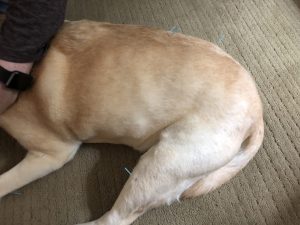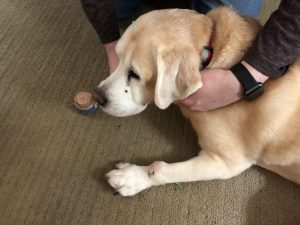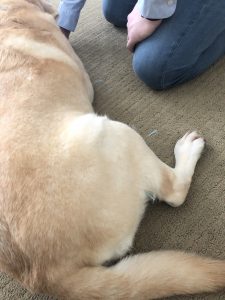Abstract:
Lucy, a 10-year-old, spayed female Labrador retriever, presented due to a chronic history of severe osteoarthritis and bilaterally ruptured cranial cruciate ligaments (CCL). Her lameness was most prevalent on her left forelimb and bilateral hindlimbs. The owner has sought acupuncture treatment in the hopes of increasing her comfort as well as reducing the frequency and doses of her medications. Lucy received four acupuncture treatments resulting in improvement in her activity level and a decrease in her pain control medications.
History of present illness and chief complaint:
Lucy is a 10-year-old, spayed female Labrador retriever canine who was presented for chronic pain and decreasing activity level due to osteoarthritis (OA) in multiple joints. Radiographs from June 2017 reported severe OA in both the right and left elbow joints. She had a tibial plateau leveling osteotomy (TPLO) performed on the left stifle in December of 2018. In the spring of 2019 she developed a firm swelling over the left carpus. The owner declined a biopsy at the time. The swelling has remained unchanged since it was first noticed. In December of 2019, she was diagnosed with a suspected partial CCL tear of the right stifle after missing a jump into the owner’s sport utility vehicle.
Lucy has difficulty rising after periods of recumbency. She no longer asks to play fetch and has stopped jumping on the couch and bed. The owner also feels that she is moving more slowly in general.
Lucy also has a lifelong history of atopy and chronic intermittent yeast and bacterial skin infections. She is currently under the care of a board certified dermatologist.
Current medications include:
Carprofen 50mg per os (PO) twice daily, Gabapentin 600mg PO three times daily, Codeine 30mg PO up to twice daily as needed, Apoquel 16mg PO once daily and hyposensitization serum injections every 15-20 days with an altering dosing schedule as needed based on her clinical signs.
Lucyside12.13.19 Lucyaway12.13.19
Physical Examination and Assessments:
Lucy weighed 30kg with a body condition score (BCS) of 8/9. She was bright, alert and responsive. Her temperature, heart rate, and respiratory rate were within normal limits (WNL). Her heart and lung auscultation revealed no heart murmur, a normal sinus arrhythmia, and clear lung sounds. Her abdomen was soft and non-painful on palpation with no obvious masses. She has multiple sebaceous adenomas on her face, pinna, and back. The musculoskeletal exam showed a 1cm x 1cm x 0.5cm hard swelling over the anterior aspect of the left carpus with associated saliva staining of the fur. There is thickening of both elbow joints and both stifle joints. Joint effusion was not appreciated in any of the affected joints. Crepitus was noted in both elbow and both stifle joints with flexion and extension. There was decreased flexion in the left elbow and left and right stifles. A minimal cranial drawer sign was present in the right stifle. Lucy stands and walks with splayed digits, bearing her weight on the ventrolateral aspect of her feet. The neurological exam showed that Lucy was mentally appropriate with normal cranial nerve function. Her conscious proprioception/postural reactions were WNL. She showed normal biceps and triceps reflexes in the forelimbs and normal sciatic and patellar reflexes in the hindlimbs.
Gait analysis shows a grade 4/5 lameness on the left forelimb, and grade 3/5 lameness in both hind limbs. She stands and walks with a relatively flat back. Her head bobs up when the left forelimb is in the weight bearing phase of the stride. There is minimal flexion in the hocks and stifles.
Myofascial pain and reactions were noted from L3 – L7 with palpation. There was muscular tension appreciated in the left tricep and bicep, cervical spinal muscles, as well as quadriceps bilaterally. Moderate muscle atrophy was noted in the left quadriceps and hamstring muscles with mild atrophy in the same muscles of the right hind leg.
Problem List:
1. Left forelimb lameness
2. Bilateral hindlimb lameness
3. Myofascial restriction L3 -L7
4. Muscle tension L3 – L7
5. Quadriceps and hamstring muscle atrophy
6. Atopy
7. Sebaceous adenomas
8. Obesity
Differential Diagnosis:
1. Left forelimb lameness
–vascular: fibrocartilagenous emboli
–infectious: lyme disease
–neoplastic: osteosarcoma
–degenerative: osteoarthritis
–iatrogenic: overuse
–congenital: elbow dysplasia
–autoimmune: immune mediated polyarthritis (IMPA)
–traumatic: fracture
–metabolic: nutritional imbalances
–myofascial: nerve entrapment, compensatory strain pattern
2. Bilateral hindlimb lameness:
–vascular: fibrocartilaginous emboli
–infectious: septic arthritis
–neoplastic: chondrosarcoma
–degenerative: osteoarthritis
–iatrogenic: missed jump into vehicle
–congenital: CCL rupture, coxofemoral joint dysplasia
–autoimmune: IMPA
–traumatic: coxofemoral luxation
–metabolic: hyperparathyroidism
–myofascial: atrophy secondary to disuse
Definitive/Putative Diagnosis:
1. Based on radiographic evidence, osteoarthritis was diagnosed in the left elbow. A putative diagnosis of osteoarthritis was made in left carpus based on clinical history and physical examination findings.
2. A diagnosis of bilateral CCL rupture was made based on clinical history and physical examination findings.
Medical Decision Making:
Because of the owner’s desire to control Lucy’s pain and to reduce her dependence on medication, efforts were made to provide generalized pain relief to the most affected joints. It was decided not to focus on her atopy as the owner felt her symptoms were fairly well controlled at this time. Dry needling and medical massage were used. Central points used in the treatments included: Yin Tang, Bai Hui, GV 14, BL 23 and 25. Autonomic points chosen included: ST 36, GV 14 and BL 40. Peripheral points used included: LI 10, LI 11, HT 3, HT 7 and SP 10.



Medial Acupuncture and Related Techniques Used:
Treatment 1, December 13, 2019:
Seirin 0.20 x 30mm, 12 minute treatment
Dry needling: GV 14, LI 11, Bai Hui, BL 23, BL 25, ST 36, BL 40, SP 10
Massage to cervical spinal muscles
Treatment 2, December 20, 2019:
Seirin 0.20 x 30mm, 10 minute treatment
Dry needling: GV 14, Bai Hui, BL 23, BL 25, LI 10, LI 11, ST 36, BL 40, HT 7
Massage to cervical spinal muscles
Treatment 3, January 2, 2020
Seirin 0.20 x 30mm, 15 minute treatment
Dry Needling: GV 14, Bai Hui, Yin Tang, ST 36, LI 11, LU 7, HT 7, BL 40
Massage to quadriceps and cervical spinal muscles
Treatment 4, January 19, 2020
Seirin 0.20 x 30mm, 15 minute treatment
Dry Needling: GV 14, Yin Tang, Bai Hui, LI 10, LI 11, HT 7, LU 7, ST 36
Outcome/Discussion: With each successive treatment, signs of improvement were noted. After the first treatment, the owner reported that Lucy had begun jumping on the couch. After the second treatment, she jumped on the owner’s bed several times during the week. At the time of the fourth treatment, Lucy greeted me at the door carrying a toy and seeking to play fetch. She was moving more quickly by the fourth treatment. The owner had stopped giving Codeine altogether and had decreased the frequency of Gabapentin dosing to twice daily. The owner was very happy with Lucy’s improvement and plans to continue treatments on a regular basis.
I believe Lucy may have made quicker improvements if I had access to a laser and electroacupuncture machines at the time of treatment, and once they become available, I will add them to her treatment protocols as appropriate.
References:
Linsey M. Fry, DVM, Susan M. Neary, DVM, Joseph Sharrock, DVM, Jessica K. Rychel, DVM, DACVSMR. Acupuncture for analgesia in veterinary medicine. Topics in Companion Animal Medicine. 2014; Volume 29, Issue 2. 35-42. Science Direct
Zhang Q., Yue J., Golianu B., Sun Z., Lu Y. (2017 Dec). “Updated systematic review and meta-analysis of acupuncture for chronic knee pain.” Acupuncture in medicine: Journal of the British Medical Acupuncture Society, Vol. 35(6), pg 392-403.